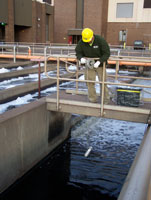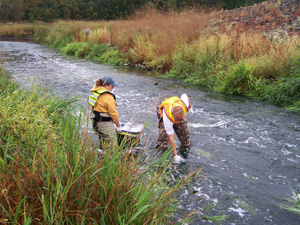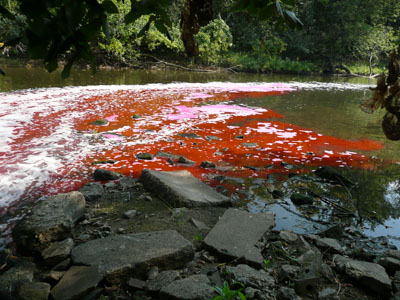Minnesota Water Science Center

Endocrine Active Chemicals/Wastewater Treatment PlantMinnesota PROJECTSABOUT THE MINNESOTA
|
APPROACH AND METHODS Study Design
A longitudinal sampling design was utilized to sample the wastewater effluent and surface-water sites upstream and downstream from the effluent discharge in each receiving water. The upstream sample provides information about contaminants originating from sources other than the WWTP of interest, and the downstream sample provides information about contributions of contaminants from the wastewater effluent. This study was designed to use chemical and biological measures to assess the presence and effects of EACs and pharmaceuticals in Minnesota WWTP effluents and receiving waters. Chemical analyses and in-vitro and in-vivo (estrogenicity) bioassays were used because each method has advantages and disadvantages addressing different questions. In this study, chemical data for EACs and other contaminants indicative of anthropogenic influence provided quantitative measures of the effects of WWTP effluents and land use on Minnesota surface waters. In-vitro cellular assays provide a method to measure the “total estrogenicity” of an aquatic environment, and in-vivo caged fish experiments provide a method to measure whole-organism responses. Site SelectionTwenty-five WWTPs (and associated receiving streams) were selected (map | site list). Wastewater-treatment plants were selected to include continuous flow and periodic release facilities with differing processing steps (activated sludge or trickling filters) and plant design flows ranging from 0.002 to 10.9 cubic meters per second (0.04 to 251 million gallons per day) throughout Minnesota in varying land-use settings. 
The U.S. Geological Survey collected water samples from the treated effluent of the 25 wastewater-treatment plants and at one point upstream from and one point downstream from wastewater-treatment plant effluent discharges. Bed-sediment samples also were collected at each of the stream or lake locations. Collection occurred from September through November 2009. Streamflow was measured at each stream site following USGS protocols. Basic water-quality properties (dissolved oxygen, pH, specific conductance, temperature, and turbidity) were measured at each site using a submersible YSI (Yellow Springs Instruments) data sonde (Yellow Springs, Ohio). Tracer studies using rhodamine WT dye (20-percent active ingredient, Ben Meadows®, Janesville, Wisc.) were performed at selected WWTPs. 
Water samples were analyzed for major ions, nutrients, trace elements, pharmaceuticals, phytoestrogens and pharmaceuticals, alkylphenols and other neutral organic chemicals, carboxylic acids, and steroidal hormones (list of chemicals). A subset (25 samples) of the bed-sediment samples were analyzed for carbon, wastewater-indicator chemicals, and steroidal hormones; the remaining samples were archived. Biological characteristics were determined by using an in-vitro bioassay to determine total estrogenicity in water samples and a caged fish study to determine characteristics of fish from experiments that exposed fish to wastewater effluent in 2009. St. Cloud State University deployed and processed caged fathead minnows at 13 stream sites during September 2009 for the caged fish study. Measured fish data included length, weight, body condition factor, and vitellogenin concentrations. |